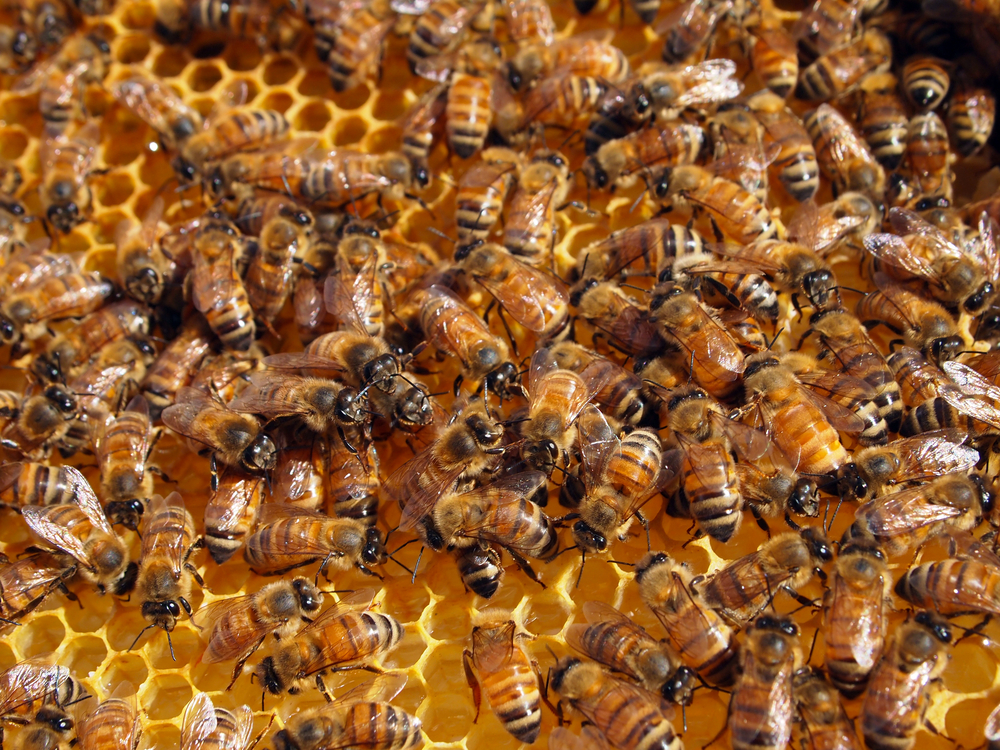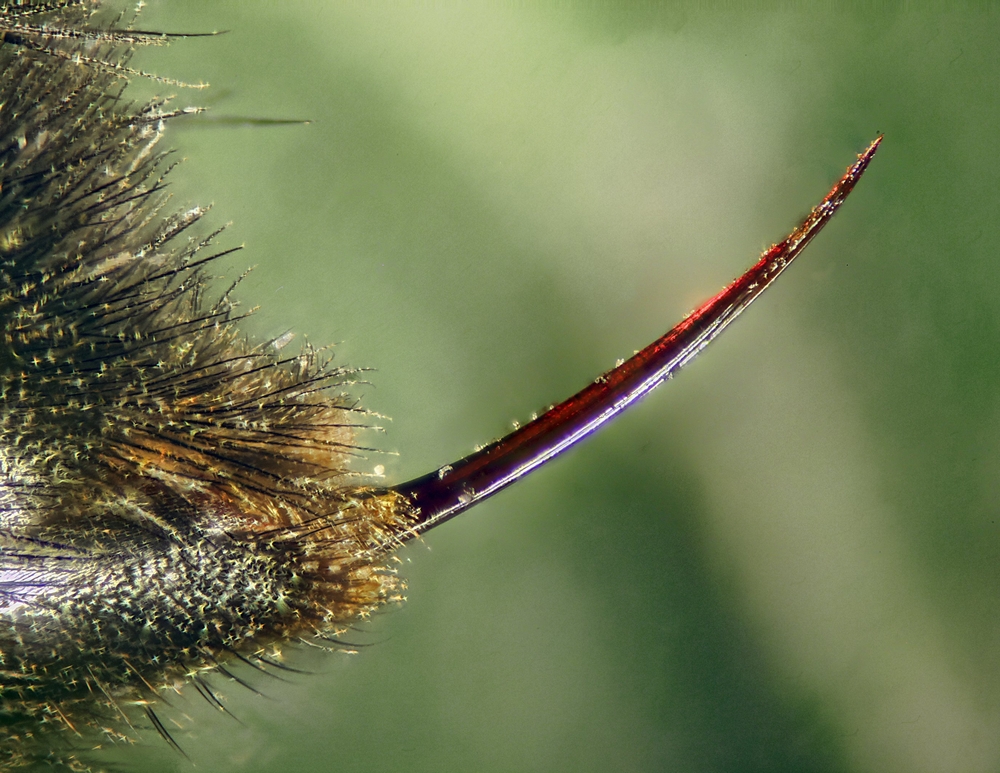Table of Contents (click to expand)
A bee’s stinger is barbed. When it stings an animal with thick skin, like a mammal, the stinger gets stuck in the skin. As the bee flies away, the stinger remains behind, along with the attached venom sack. The bee now has a hole in its body and subsequently dies.
Ever wonder why bees sting? It isn’t for an aggressive reason, as we often assume and depict in media. Bees only sting when they feel the need to defend themselves; it is a defensive, rather than an offensive maneuver.
However, did you know that in defending themselves from danger, bees unintentionally sacrifice their own life when they sting you? Honeybees self-amputate a part of their abdomen, much like frontline defense soldiers being killed in action, to protect the hive.
Can All Bees Sting?
Generally, in most bee species, male bees are incapable of stinging. These ‘stingless bees’ do exactly what their name suggests: they don’t sting. However, this is not due to the absence of a stinger, but due to its ineffectiveness.
The males of Xylocopa, a species of carpenter bee, may follow you with an air of intimidation, but they’re pretty harmless and don’t sting. The same can be said about bumblebee males too. Even though many solitary bee species have stingers, stings are quite uncommon from the most prevalent species (such as mason bees, mining bees, and leaf-cutters).

Also Read: Why Does A Bee-Sting Hurt So Much And What Can You Do About It?
A Female Bee’s Sting
Looking at the constitution of a hive, each will typically have hundreds of male bees (drones), a reproductively active female queen bee, and 20,000-80,000 worker (all females and all sisters) bees. However, their abundance and infertility make them somewhat disposable. Additionally, as the main workforce of the colony, defense is one of their top priorities. When aggravated, they do sting. These females form the only proportion of the colony that will use their stinger for its painful purpose!

Also Read: What Happens To Bees When They Get Lost?
What Is A Bee Stinger?
A stinger is present in all species belonging to the group (subclade) Aculeata, which includes wasps, ants, honeybees, and hornets.
The stinger is a modified ovipositor, which is associated with venom glands.
The body of a honeybee is divided into the head, thorax, and abdomen. The abdomen is segmented and there are 9-10 segmental units. The last segment is appropriately named the sting chamber, as it houses the sting apparatus. Since this chamber is continuous with the other abdominal segments, it also contains the final part of a bee’s digestive tract. Nerve ganglions, retractor and protractor muscles that push and retract the stinger into the prey, and a bulb that acts as a venom-storing structure, can also be found in this region.
The stinger is a modified ovipositor, a tubular female organ that is used to deposit eggs. Thus, it makes sense that only the female bees have a stinger that actually works!
Though their ovipositor no longer functions as an egg-laying organ, the workers have retained it across evolutionary time for use in defending their home.

A queen bee can also sting, but she only puts her stinger to use when facing competition from another potential queen.
How Does A Stinger Work?
Morphologically, the stinger is hollow and pointy, with two rows of serrated and barbed blades, resembling a harpoon.
Upon encountering a potential threat, a worker bee will decide to use its go-to defense mechanism. The protracted muscles accompanying the stinger apparatus will move the stinger down, enabling the bee to penetrate its prey. To create enough thrust to penetrate through thick skin (if need be), the bee additionally uses its legs and abdominal muscles. Once the stinger is driven in, the venom sac releases its contents through a channel in the stinger. Subsequently, the retractor muscles will help in the retrograde movement of the stinger shaft.
Research has shown that the stinger moves both helically and in a clockwise direction as it penetrates its target. However, as the stinger is barbed, it offers a lot of resistance, making it almost impossible for the bee to remove it after making the strike.
Most bees and their queens, along with wasps and hornets, may have a reputation for being fierce stingers, but thanks to their smooth stingers, they don’t necessarily have to die after they sting you. The stinger will release its venom and effortlessly slide out.
The worker honeybee, unfortunately, has a barbed stinger that only gives them one chance.
The instant her stinger pierces the target, it gets lodged in the prey’s skin. In an attempt to fly away, the bee tries to break free, but, in the process, ruptures the lower portion of her abdomen. Everything present in the last abdominal segment, including muscles, digestive material, venom sac, and glands, is left behind with the strongly anchored stinger.
Needless to say, having a hole in their abdomen doesn’t do the bee any good. After a short period, the bee will die. This is an act of autotomy, wherein an organism leaves its body part or cuts part of its body off, in order to escape a predator or any other form of danger.
Closing Thoughts
A painful abdominal rupture does no good to the bee, so why do bees sting? Maybe they’re being altruistic and sacrificing their lives for the protection of their entire colony. As infertile individuals, they cannot bear offspring and directly contribute to the gene pool of their hive. Instead, they do their part in ensuring the safety of those individuals who can help in the persistence and success of the colony.
How well do you understand the article above!

References (click to expand)
- Ab Hamid, S., Salleh, M. S., Thevan, K., & Hashim, N. A. (2021, August 8). Distribution and Morphometrical Variations of Stingless Bees (Apidae: Meliponini) In Urban and Forest Areas of Penang Island, Malaysia. Journal of Tropical Resources and Sustainable Science (JTRSS). Universiti Malaysia Kelantan.
- WYS Know —. Carpenter Bees - DigitalCommons@USU. Utah State University
- Ch05 - FAO. Food and Agriculture Organization of the United Nations
- Barbosa, D. N., Vilhelmsen, L., & Azevedo, C. O. (2021, January). Morphology of sting apparatus of Chrysidoidea (Hymenoptera, Aculeata). Arthropod Structure & Development. Elsevier BV.
- Stephen, W. P., Bohart, G. E., & Torchio, P. F. (1969). The biology and external morphology of bees ; with a synopsis of the genera of northwestern America.
- Sting Glands in Stingless Bees: A Vestigial Character (Hymenoptera: Apidae) - archive.org
- Weyda, F., & Kodrík, D. (2020, November 3). New functionally ultrastructural details of the honey bee stinger tip: serrated edge and pitted surface. Journal of Apicultural Research. Informa UK Limited.
- Mulfinger, L., Yunginger, J., Styer, W., Guralnick, M., & Lintner, T. (1992, March 1). Sting Morphology and Frequency of Sting Autotomy Among Medically Important Vespids (Hymenoptera: Vespidae) and the Honey Bee (Hymenoptera: Apidae). Journal of Medical Entomology. Oxford University Press (OUP).
- Dotimas, E. M., & Hider, R. C. (1987, January). Honeybee Venom. Bee World. Informa UK Limited.
- Wu, J., Yan, S., Zhao, J., & Ye, Y. (2014, August 4). Barbs Facilitate the Helical Penetration of Honeybee (Apis mellifera ligustica) Stingers. (F. Frischknecht, Ed.), PLoS ONE. Public Library of Science (PLoS).
